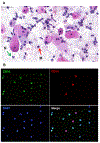Clinical Chorioamnionitis at Term: New Insights into the Etiology, Microbiology, and the Fetal, Maternal and Amniotic Cavity Inflammatory Responses
- PMID: 30320312
- PMCID: PMC6177213
Clinical Chorioamnionitis at Term: New Insights into the Etiology, Microbiology, and the Fetal, Maternal and Amniotic Cavity Inflammatory Responses
Abstract
Clinical chorioamnionitis is the most common infection related diagnosis made in labor and delivery units worldwide. It is traditionally believed to be due to microbial invasion of the amniotic cavity, which elicits a maternal inflammatory response characterized by maternal fever, uterine tenderness, maternal tachycardia and leukocytosis. The condition is often associated with fetal tachycardia and a foul smelling amniotic fluid. Recent studies in which amniocentesis has been used to characterize the microbiologic state of the amniotic cavity and the inflammatory response show that only 60% of patients with the diagnosis of clinical chorioamnionitis have proven infection using culture or molecular microbiologic techniques. The remainder of the patients have intra-amniotic inflammation without demonstrable microorganisms or a maternal systemic inflammatory response (fever) in the absence of intra-amniotic inflammation. The latter cases often represent a systemic inflammatory response after epidural anesthesia/analgesia has been administered. The most common microorganisms are Ureaplasma species and Gardnerella vaginalis. In the presence of ruptured membranes, the frequency of infection is 70%, which is substantially higher than patients who have intact membranes (25%). The amniotic fluid inflammatory response is characterized by an infiltration of neutrophils and monocytes. Both cell types are activated in the presence of infection and can produce inflammatory cytokines. The white blood cells in the amniotic fluid can be of fetal or maternal origin. The maternal inflammatory response is characterized by an elevation in the concentration of pyrogenic cytokines. The cytokine plasma concentrations in the fetal circulation are elevated even if there is no evidence of an intra-amniotic inflammatory response suggesting that maternal plasma cytokines may cross the placental barrier and induce a mild fetal inflammatory response. Placental pathology is of limited value in the diagnosis of proven intra-amniotic infection. The clinical criteria traditionally used in clinical medicine have accuracy around 50% and therefore, they cannot distinguish between patients with a proven intra-amniotic infection and those with intra-amniotic inflammation alone. Analysis of amniotic fluid with a bedside test for MMP-8 can allow the rapid identification of the patient at risk for infection and may decrease the need for antibiotic administration to neonates. An important consideration is whether antibiotics effective against Ureaplasma species should be administered to patients with clinical chorioamnionitis, given that these genital mycoplasmas are the most common organisms found in the amniotic fluid. The emergent picture is that clinical chorioamnionitis is a heterogeneous syndrome, which requires further study to optimize maternal and neonatal outcomes.
Keywords: Intra-amniotic infection; MMP-8; amniotic fluid; antibiotics; biomarkers; cytokines; fetal tachycardia; maternal fever; maternal morbidity; monocytes; neonatal morbidity; neutrophils; rapid diagnosis; treatment.
Conflict of interest statement
Disclosure: The authors report no conflict of interest.
Figures



Similar articles
-
Clinical chorioamnionitis at term: definition, pathogenesis, microbiology, diagnosis, and treatment.Am J Obstet Gynecol. 2024 Mar;230(3S):S807-S840. doi: 10.1016/j.ajog.2023.02.002. Epub 2023 Mar 21. Am J Obstet Gynecol. 2024. PMID: 38233317 Free PMC article. Review.
-
Clinical chorioamnionitis at term X: microbiology, clinical signs, placental pathology, and neonatal bacteremia - implications for clinical care.J Perinat Med. 2021 Jan 26;49(3):275-298. doi: 10.1515/jpm-2020-0297. Print 2021 Mar 26. J Perinat Med. 2021. PMID: 33544519 Free PMC article.
-
Clinical chorioamnionitis at term VIII: a rapid MMP-8 test for the identification of intra-amniotic inflammation.J Perinat Med. 2017 Jul 26;45(5):539-550. doi: 10.1515/jpm-2016-0344. J Perinat Med. 2017. PMID: 28672752 Free PMC article.
-
Clinical chorioamnionitis at term V: umbilical cord plasma cytokine profile in the context of a systemic maternal inflammatory response.J Perinat Med. 2016 Jan;44(1):53-76. doi: 10.1515/jpm-2015-0121. J Perinat Med. 2016. PMID: 26360486 Free PMC article.
-
Acute chorioamnionitis and funisitis: definition, pathologic features, and clinical significance.Am J Obstet Gynecol. 2015 Oct;213(4 Suppl):S29-52. doi: 10.1016/j.ajog.2015.08.040. Am J Obstet Gynecol. 2015. PMID: 26428501 Free PMC article. Review.
Cited by
-
The origin of amniotic fluid monocytes/macrophages in women with intra-amniotic inflammation or infection.J Perinat Med. 2019 Oct 25;47(8):822-840. doi: 10.1515/jpm-2019-0262. J Perinat Med. 2019. PMID: 31494640 Free PMC article.
-
Management of clinical chorioamnionitis: an evidence-based approach.Am J Obstet Gynecol. 2020 Dec;223(6):848-869. doi: 10.1016/j.ajog.2020.09.044. Epub 2020 Sep 29. Am J Obstet Gynecol. 2020. PMID: 33007269 Free PMC article. Review.
-
Histological chorioamnionitis and its predictors among mothers with premature rupture of membranes delivering at tertiary hospitals in Uganda: a multicenter cross-sectional study.BMC Pregnancy Childbirth. 2025 Feb 6;25(1):128. doi: 10.1186/s12884-025-07245-4. BMC Pregnancy Childbirth. 2025. PMID: 39915707 Free PMC article.
-
Probiotics Dietary Supplementation for Modulating Endocrine and Fertility Microbiota Dysbiosis.Nutrients. 2020 Mar 13;12(3):757. doi: 10.3390/nu12030757. Nutrients. 2020. PMID: 32182980 Free PMC article. Review.
-
Predictive Screening for Inflammatory Disorders of Pregnancy Using Targeted Maternal Cell-Free RNA Assays: Proof-of-Principle Data from Large Animal and Human Cohorts.Reprod Sci. 2025 Jul;32(7):2340-2361. doi: 10.1007/s43032-025-01876-w. Epub 2025 Jun 4. Reprod Sci. 2025. PMID: 40464837 Free PMC article.
References
-
- Malloy MH. Chorioamnionitis: epidemiology of newborn management and outcome United States 2008. J Perinatol. 2014;34(8):611–5. - PubMed
-
- Rouse DJ, Landon M, Leveno KJ, Leindecker S, Varner MW, Caritis SN, et al. The Maternal-Fetal Medicine Units cesarean registry: chorioamnionitis at term and its duration-relationship to outcomes. Am J Obstet Gynecol. 2004;191(1):211–6. - PubMed
-
- Newton ER. Chorioamnionitis and intraamniotic infection. Clin Obstet Gynecol. 1993;36(4):795–808. - PubMed
-
- Gibbs RS, Blanco JD, St Clair PJ, Castaneda YS. Quantitative bacteriology of amniotic fluid from women with clinical intraamniotic infection at term. J Infect Dis. 1982;145(1):1–8. - PubMed
Grants and funding
LinkOut - more resources
Full Text Sources
